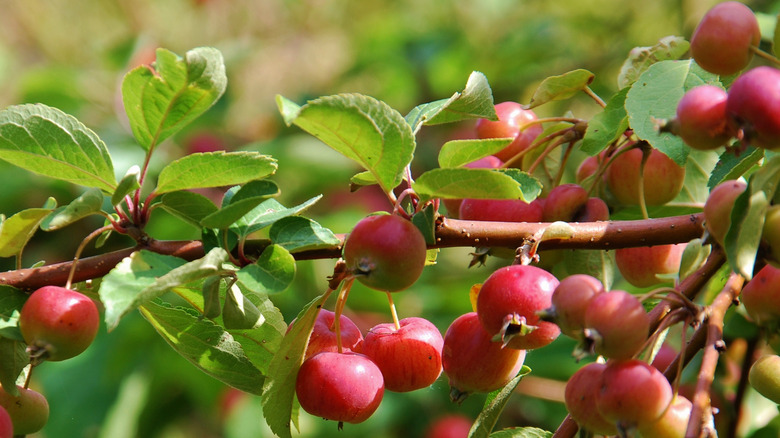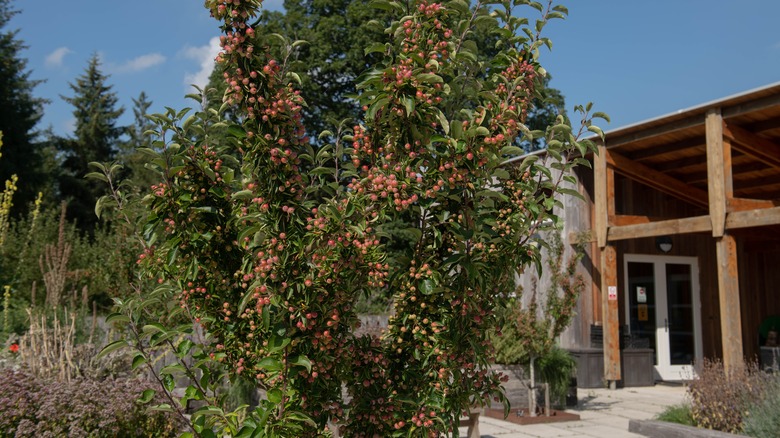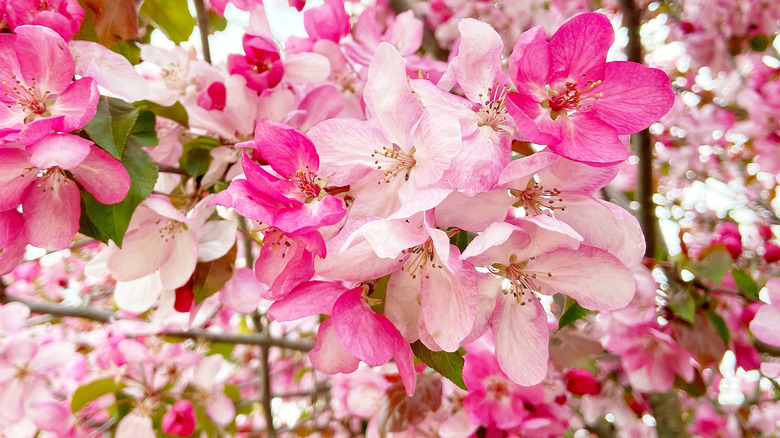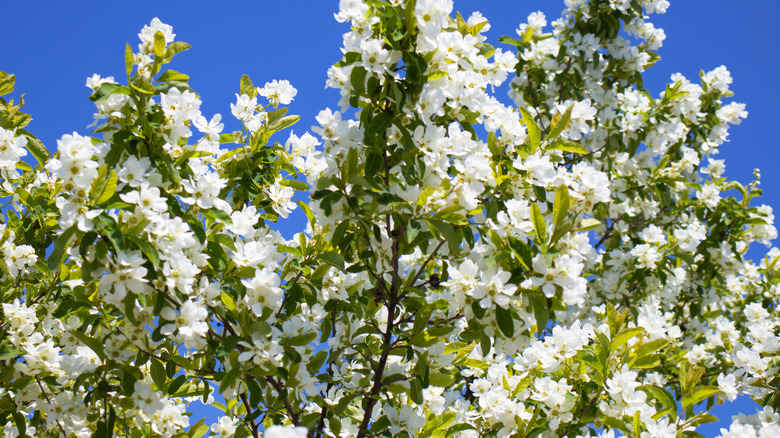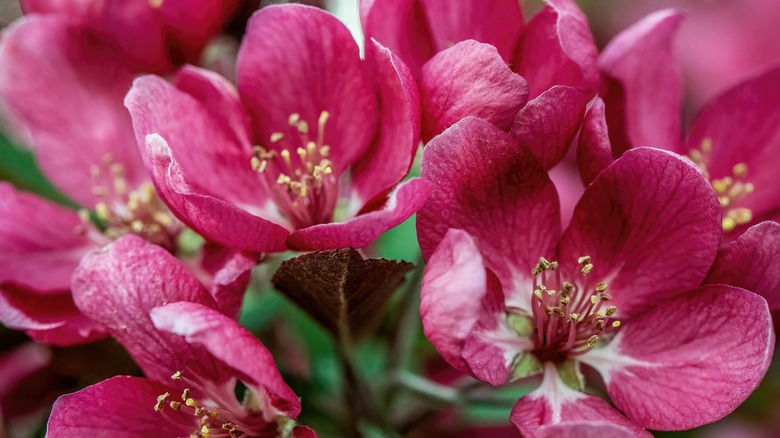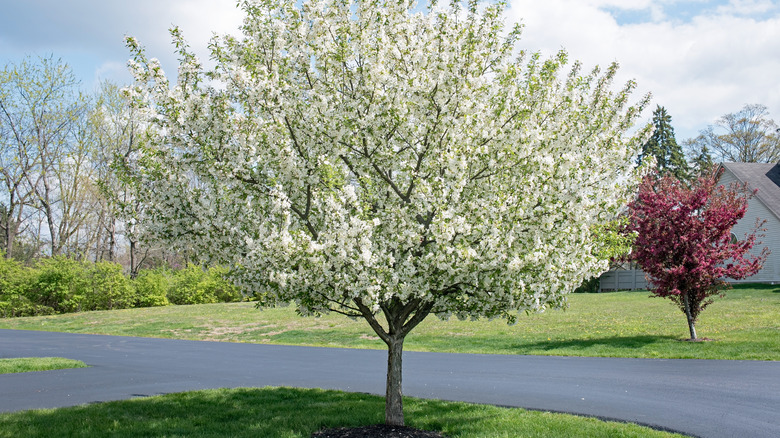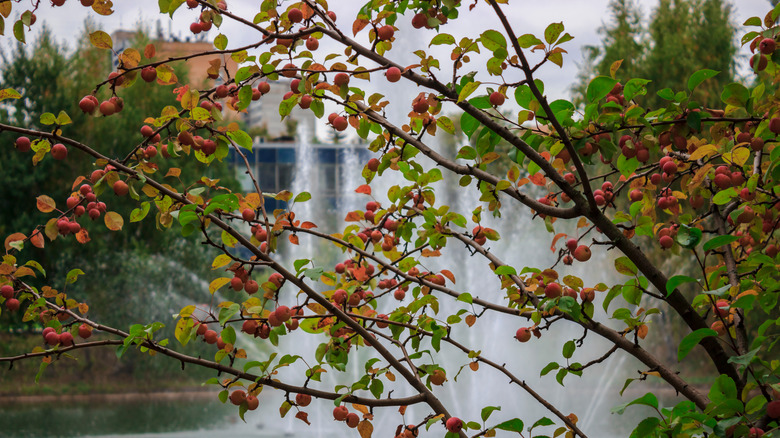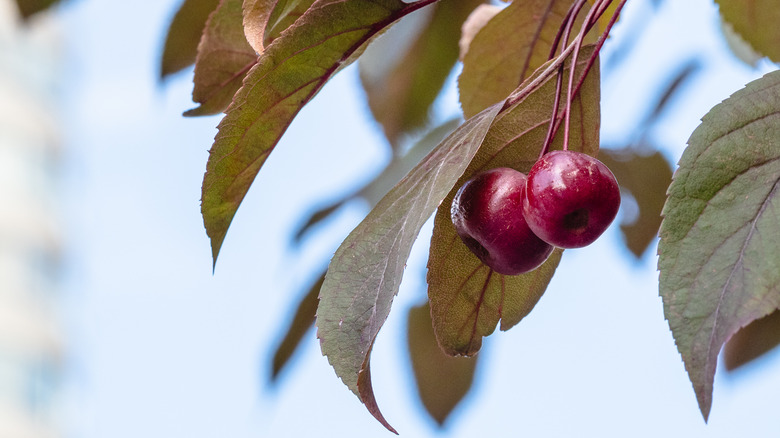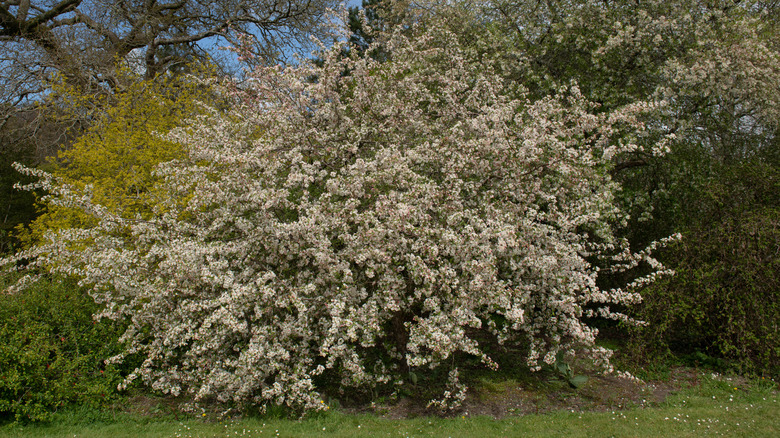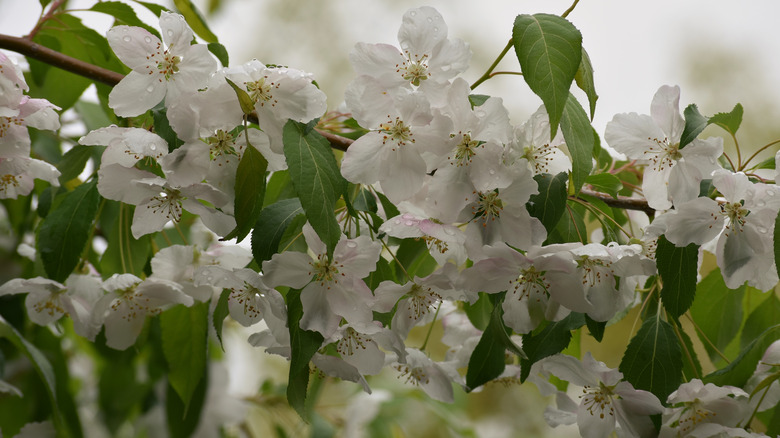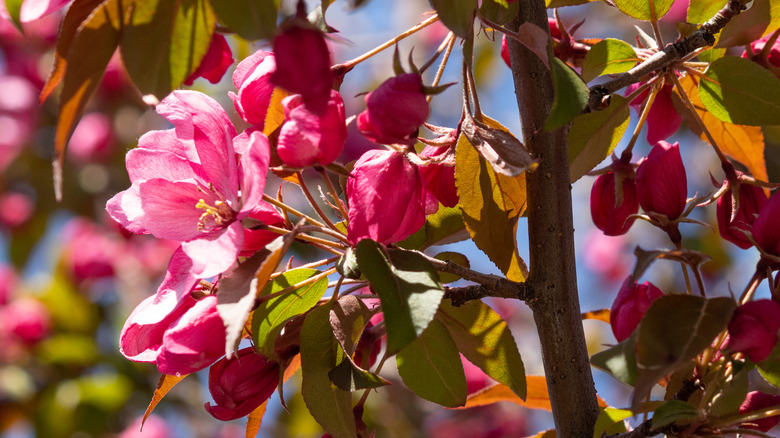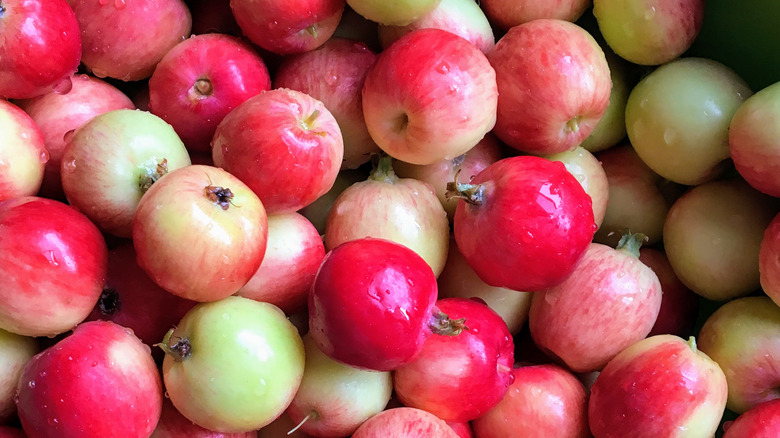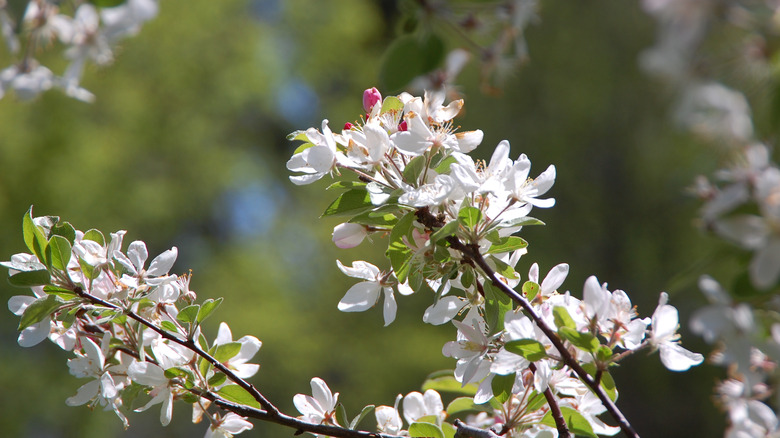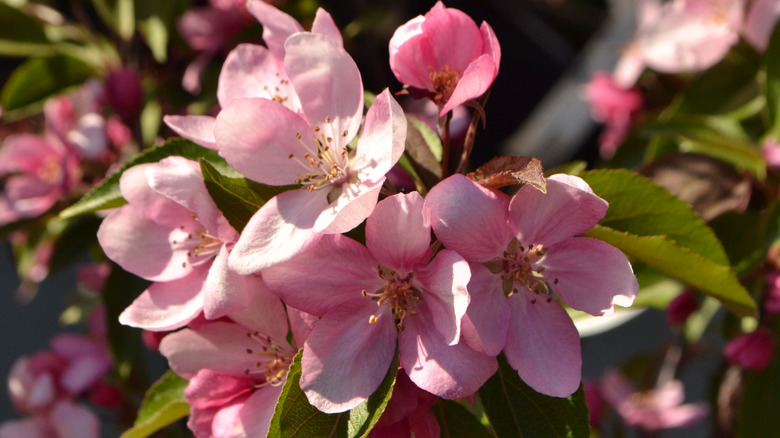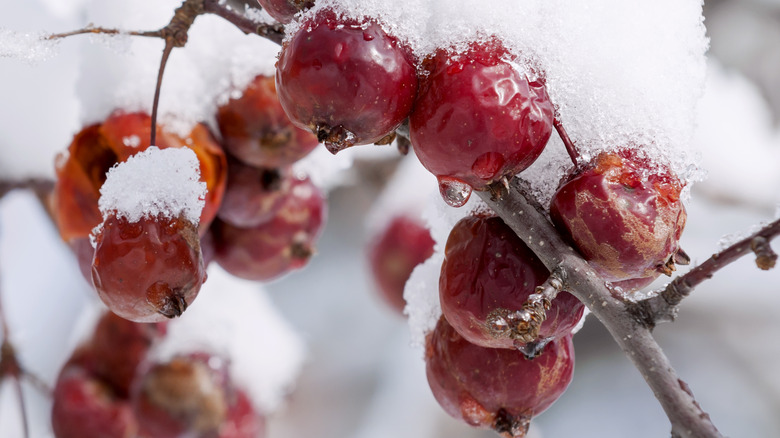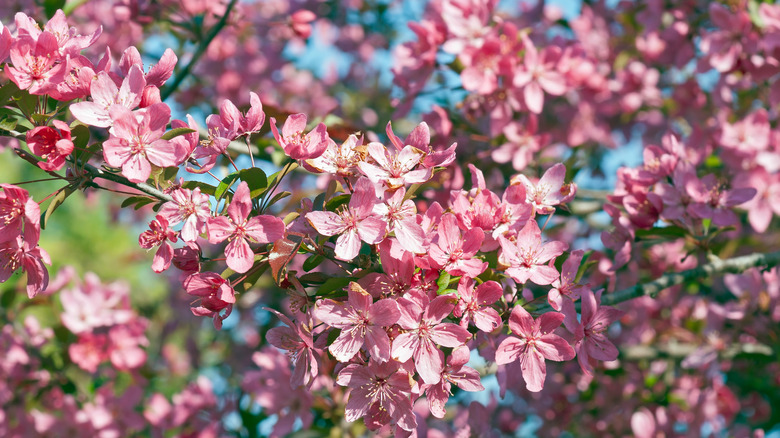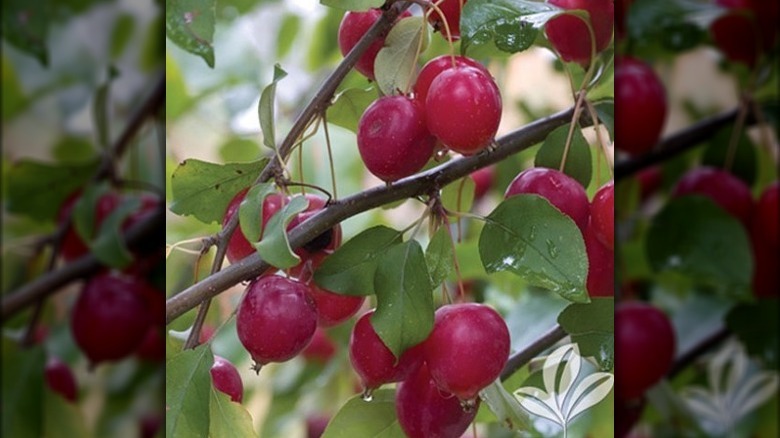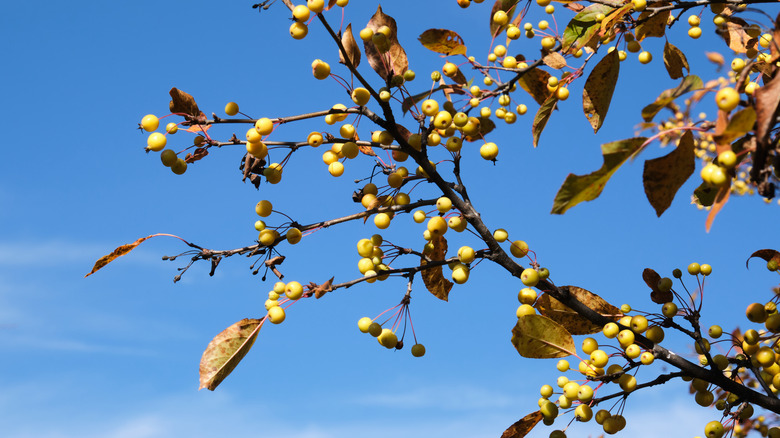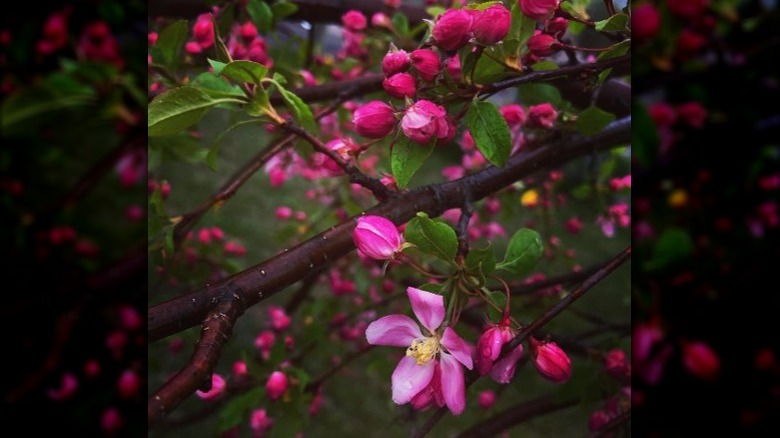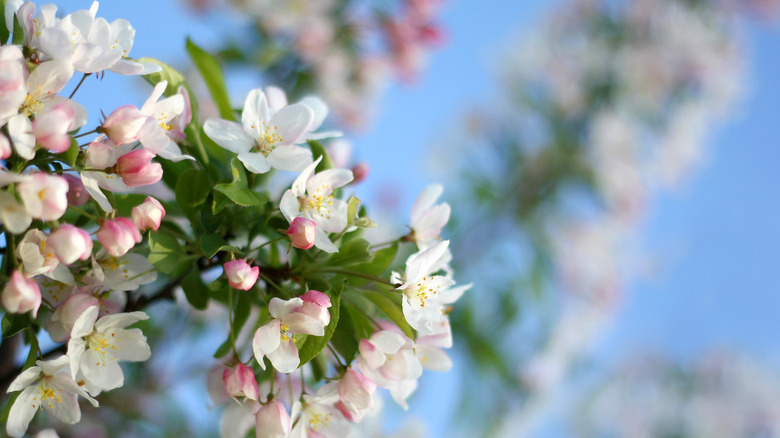20 Types Of Crabapple Trees You Can Grow In Your Yard
One of the best aspects of gardening is choosing the perfect tree to complete your backyard. You can pick a tree to create shade for summertime picnics, to serve as a focal point for your garden, or to create a natural fence between you and your neighbors or the street. While not every plant has to be functional, you still want something pleasing to the eye and complementary to the rest of your garden.
A crabapple tree (Malus sylvestris) serves that very purpose. Gardenia notes that when shopping for different types of crabapple trees for your yard, you might want to consider some qualities such as the color of the blossoms, fruit, and leaves. You also might want to research the tree's height and some factors regarding its care, such as the amount of sun exposure needed and the soil type for planting. So without further ado, we bring you a variety of crabapple trees for your next landscaping project.
1. Adirondack crabapple tree
This type of crabapple tree, known as the Adirondack (Malus Adirondack), gives you both fruit and flowers. According to Better Homes and Gardens, it grows lovely white blossoms in the spring, and fruit in the fall and early winter. Its narrow spread and sizable height make it ideal for a large yard.
Bloom Season: Mid-spring
USDA Growing Zone: 4 through 8
Growing Conditions: Full sun
Soil Type: Loam, clay, sand, neutral
Size: Up to 18 feet
2. Coralburst crabapple tree
The Coralburst (Malus coralcole) grows slowly up to its 10-foot height, making it a great option for your yard. J. Frank Schmidt & Son Co. notes that the rose-colored blossoms give rise to bronze-toned fruit, which offers a pleasing contrast to its dark green foliage. This type of crabapple tree needs moderate watering and full exposure to the sun for optimal tree health (via Monrovia).
Bloom Season: Spring
USDA Growing Zone: 3 through 8
Growing Conditions: Full sun
Soil Type: Any type; well-drained/regular watering
Size: 15 feet
3. White cascade crabapple tree
The White Cascade crabapple tree (Malus cascole) makes an excellent choice for an ornamental, weeping tree. According to Backyard Gardener, its white blossoms appear in late spring, which grow into small, yellow fruit. This crabapple tree needs partial to full sun to thrive. When you first plant it, you'll need to create a small "moat" around it for watering. As it matures, it should need regular watering.
Bloom Season: Mid to late spring
USDA Growing Zone: 4 to 8
Growing Conditions: Partial to full sun
Soil Type: Sand and clay
Size: 12 feet
4. Indian magic crabapple tree
The Indian magic crabapple tree (Malus × 'Indian Magic') gives you an ornamental option for your yard with its deep pink, almost violet blossoms, and vibrantly red fruit. The green foliage turns a lovely shade of red in the fall, as noted by the Santa Fe Botanical Garden. With a slightly rounded shape and branches that reach upward, this tree will compliment your landscape throughout the year.
Bloom Season: Mid-spring
USDA Growing Zone: 1 through 10; 14 through 21
Growing Conditions: Full sun; drought tolerant
Soil Type: Clay, chalk, loam, sand; well-draining
Size: Up to 15 feet
5. Lollipop crabapple tree
This type of crabapple tree, known as the Lollipop (Malus lollizam), gives you a great alternative to topiaries or plain, green shrubs, according to plant brand Proven Winners. With its short height and naturally curved and compact shape, the Lollipop crabapple tree makes an ideal addition to a small garden or a corner of the patio. In addition to the green leaves and white blossoms, you'll also gain some pleasing red fruit.
Bloom Season: Spring
USDA Growing Zone: 4 through 8
Growing Conditions: Full sun for at least 6 hours
Soil Type: Acidic soil that's kept moist but well-drained
Size: Up to 8 feet
6. Adams crabapple tree
According to SF Gate, the Adams crabapple tree (Malus adams) offers eye-catching appeal during all seasons. The bright pink blossoms make way for the shiny, red fruit surrounded by greenish, reddish foliage. This type of crabapple tree proves to be one of the taller varieties, so a late winter pruning keeps its broad reach in check.
Bloom Season: Spring
USDA Growing Zone: 4 through 8
Growing Conditions: Full sun
Soil Type: Acidic loam soil
Size: Up to 20 feet
7. Pink princess crabapple tree
The Pink Princess crabapple tree (Malus parrsi) is a shorter form of the Sargent whose trademark is its red leaves, according to Missouri Botanical Garden. Its deep red fruit also adds to this tree's charm, while its horizontal spread makes it useful for a small hedge or a corner piece in the yard. Better yet, this variety also tolerates dry weather quite well.
Bloom Season: Late spring
USDA Growing Zone: 5 through 9
Growing Conditions: Full sun
Soil Type: Moist, loamy, acidic soil
Size: 8 feet
8. Pink Sargent crabapple
Like its Pink Princess counterpart, the Sargent (Malus sargentii) tends to be shorter than most trees, as noted by Chicago Botanical Garden. Also, you can count on many shades of red throughout the year –- from red buds in early spring to red fruit in early fall. Between those seasons, you can look forward to pink or white blossoms and deep green foliage that does well with minimal pruning.
Bloom Season: Late spring to early summer
USDA Growing Zone: 4 through 8
Growing Conditions: Full sun
Soil Type: Moderate
Size: 8 feet
9. Cinderella dwarf crabapple tree
The Cinderella dwarf (Malus cinzam) gives you a low-maintenance option that you can place in a small garden, either in a corner or as the focal point. Monrovia advises maintaining the soil's moisture by surrounding the tree with mulch. Once you have your tree established, watering once a week would suffice.
Bloom Season: Middle of spring
USDA Growing Zone: 4 through 9
Growing Conditions: Full sun
Soil Type: Slightly acidic soil with a pH of no higher than 6.5
Size: Up to 8 feet
10. Velvet pillar crabapple tree
Whether you call it the Roseybloom or the Velvet Pillar (Malus 'Velvet Pillar'), this type of crabapple tree gives distinctive beauty and lots of shade to large spaces. With a column-like trunk and branches that grow upward as opposed to spreading, you'll only have to prune it once during the winter for the tree to keep its majestic shape, as per Gertens Garden Center. Best of all, the lovely, pointed leaves turn a shade of dark red, and you can look forward to red fruit in the fall.
Bloom Season: Mid-spring
USDA Growing Zone: 4
Growing Conditions: Full sun
Soil Type: Any type as long as it stays moist
Size: Up to 20 feet
11. Centennial crabapple tree
The Centennial crabapple tree (Malus centennial) bears a reddish-orange fruit that's perfect for preserving. You can make everything from jelly to apple butter to spices from the apples, according to ProGardenTips. As you go into the fall, you'll also enjoy the leaves' golden hues, adding a splash of clothing to your garden.
Bloom Season: May
USDA Growing Zone: 3 through 9
Growing Conditions: Full sun
Soil Type: Loamy
Size: 8 to 15 feet
12. Hoppa crabapple tree
The words "tough" and "beautiful" both describe the Hoppa crabapple tree (Malus hopa), thanks to its fragrant pink blossoms and semi-weeping branches, per Luv2Garden. Furthermore, you'll enjoy dark scarlet fruit that's tasty right off the branch or as canned preserves. The one consideration to keep in mind is that you'll need to prune this variety to keep it at a manageable height.
Bloom Season: Mid to late spring
USDA Growing Zone:4 through 8
Growing Conditions: Can tolerate partial sun; full sun exposure provides the best results
Soil Type: Clay and sand
Size: Up to 25 feet
13. Whitney crabapple tree
The Whitney crabapple tree (Malus pumila) produces red and yellow fruit that is ideal for cooking and making cider. As noted in One Green World, this crabapple tree offers you a great ornamental option even if you live in a climate with cold winters and hot summers.
Bloom Season: April
USDA Growing Zone: 2
Growing Conditions: Full sun for at least half the day
Soil Type: Loamy; well-drained
Size: 10 to 16 feet
14. Pink spires flowering crabapple tree
The Pink Spires variety (Malus hybrid) possesses a colorful combination of dark purple and red leaves with two-toned pink blossoms in the spring. With maroon-colored fruit in the fall and a tall and oval shape, My Garden Life recommends this tree as your yard's focal point. It will add an attractive pop of color.
Bloom Season: Early spring
USDA Growing Zone: 5 through 8
Growing Conditions: Full sun
Soil Type: Well-drained
Size: 15 feet
15. Red jewel crabapple tree
The Red Jewel (Malus x 'Red Jewel') would be quite a gem in your yard. The small tree has bright, white blossoms that develop into eye-catching red fruit, as per the University of Florida Extension. The size and shape of this variety make it ideal for a corner of a small space, or you can plant a tree at each end of a walkway leading up to your home's entrance.
Bloom Season: Spring
USDA Growing Zone: 4A Through 8A
Growing Conditions: Full sun
Soil Type: Well-drained; loamy
Size: Up to 15 feet
16. Prairifire
The Prairifire crabapple tree (Malus prairifire) features dark pink and red flowers that stick around for several weeks during the spring when the tree is blossoming. The trees grow between 13 and 24 inches each year, with mature trees reaching up to 20 feet tall with a spread of about 15 feet across. Prairifire crabapple trees are disease resistant and can thrive in a variety of soil types. While the trees may be the most beautiful when they are in bloom, they are attractive all year long. The new leaves start off as a purple color during the springtime, and then change to a darker green color with red veining during the summer. Before the leaves drop in the fall, they become a nice bronze hue.
Bloom Season: Spring
USDA Growing Zone: 3 through 8
Growing Conditions: Full sun
Soil Type: Well-drained, acidic, moist, loamy, sandy, wet, or clay
Size: 20 feet
17. Callaway
Malus x callaway, or Callawaycrabapple trees, are another disease-resistant variety that can grow well in a variety of soil conditions. While the trees may be more adaptable to different types of soil conditions, they will grow best when in a location that gets full sun throughout as much of the day as possible. The trees bloom in early April, producing gorgeous white blossoms (though the buds start a lighter pink color). Once the flowers fall, small, dark red crabapples appear. While edible, Callaway crabapples are bitter. This variety reaches heights between 15 and 25 feet and also has a spread between 15 and 25 feet. Just make sure to prune them often and inspect them for diseases, since they're slightly susceptible to issues like mildew, fireblight, and rust.
Bloom Season: Early Spring
USDA Growing Zone: 4b through 8
Growing Conditions: Full sun
Soil Type: well-drained, loam, clay, acidic, or alkaline
Size: Up to 25 feet
18. Harvest Gold
As you may be able to guess based on its name, the Harvest Gold crabapple tree (Malus hargozam) produces attractive yellow fruits. These crabapples follow the blossoms that appear on the tree in May. Before the fruit arrives, though, the tree is covered with gorgeous white flowers that catch many an eye. Harvest Gold crabapple trees reach a height between 20 and 25 feet when mature. They typically have a spread between 15 and 20 feet. With their lower branches, the trees need regular pruning if they are near sidewalks or roads. Harvest Golds are relatively easy to grow. They can be planted in a variety of soil types, though well-drained varieties are preferred. The tree is also disease-resistant.
Bloom Season: Late Spring
USDA Growing Zone: 4 through 8
Growing Conditions: Full sun
Soil Type: well-drained, occasionally wet, clay, loam, sand, acidic, or alkaline
Size: Up to 25 feet
19. Louisa
Louisa crabapple trees (Malus Louisa) are a sight to behold. They feature bowed branches that are covered with light pink flowers during the springtime. As the flowers disappear, they are replaced with small yellow to orange crabapples. If not eaten by birds and other animals, the crabapples may remain on the tree into the winter months. Like several other varieties, the Louisa is disease-resistant and fares well against potential threats such as leaf spot, scab, and fireblight. This tree grows best in full sun conditions with moderately fertile and well-drained soil types. Mature trees may grow up to 15 feet tall and up to 15 feet wide. Overall, the trees are easy to care for, but they will likely need some pruning towards the end of the winter to maintain their shape and prevent the branches from reaching the ground.
Bloom Season: Early Spring
USDA Growing Zone: 4 through 8
Growing Conditions: Full sun
Soil Type: Clay, loam, sand, chalk
Size: Up to 15 feet
20. Snowdrift
Snowdrift crabapple trees (Malus snowdrift) can reach up to 20 feet tall when fully mature. The trees also have a wide spread, possibly reaching up to 20 across. They may grow between 13 and 24 inches each year until fully mature. In the early spring, the snowdrift crabapple tree is covered with pink buds, which open up a few weeks later to reveal stunning pure white flowers. As the blossoms fade and fall, orange to red crabapples appear and cover the tree. These small fruits may remain into the winter if birds or other animals don't eat them. Snowdrift trees grow best in full sun. Like many other varieties, they are adaptable to various soil types. These trees will do best in well-drained soil, preventing their roots from getting too wet.
Bloom Season: Spring
USDA Growing Zone: 4 through 8
Growing Conditions: Full sun
Soil Type: Fertile and well-drained
Size: Up to 20 feet
